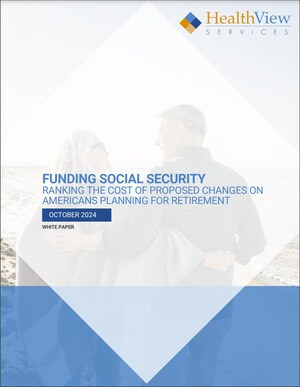HealthView Services 2016 Retirement Health Care Costs Data Report Released
Retirement Health Care Costs for a 65-Year-Old Healthy Couple to Exceed $288,000
Projected 2015-2016 Retirement Health Care Inflation: 7.3%
66-Year-Old Couple Will Require 57% of Social Security Benefits to Cover Health Care
Medicare Surcharges to Increasingly Impact Middle Class
DANVERS, Mass., May 18, 2016 /PRNewswire/ -- HealthView Services' new 2016 Retirement Health Care Costs Data Report explores emerging trends and provides detailed projections of health care expenses in retirement. The report, which was released today, reveals that health care costs for retirees, driven by health care inflation, age, and increased cost shifting, are continuing an upward trajectory.
HealthView's data shows the average healthy 65-year-old couple retiring this year is projected to spend $288,400 in today's dollars on lifetime Medicare Parts B, D and supplemental insurance (Plan F) premiums. When dental, hearing, vision and all other out-of-pocket expenses are included, the total retirement health care bill rises to $377,412.
"Few Americans have taken steps toward addressing medical expenses in retirement, and most do not understand Medicare costs," said Ron Mastrogiovanni, Founder and CEO of HealthView Services. "Our data shows the significant impact of rising health care costs and the importance of planning for them."
For retirees counting on Social Security income, HealthView Services' Retirement Health Care Cost Index® shows the portion of benefits required to cover projected lifetime medical expenses. A 66-year-old couple retiring this year will need 57% of their Social Security to cover total health care costs. A 55-year-old couple retiring in 10 years will require 88%, and a 45-year-old couple, 116%. These calculations are based on Social Security Trustees' projections of a 3.1% Cost of Living Adjustment (COLA) in 2017 and 2.7% thereafter.
According to Mastrogiovanni, "What has not changed is that many Americans will still see a significant portion of their Social Security income consumed by health care costs; for some, medical expenses could eventually exceed their benefits."
A key cost driver is health care inflation in retirement. Overall retirement health care costs are projected to have increased by 7.3% between 2015 and 2016, driven in part by a 16.1% increase in Medicare Part B premiums over the same period. Over the next 20 years, HealthView projects a more modest average annual inflation rate of 5.1% for retirement health care expenses. This is consistent with forecasts from the Centers for Medicare and Medicaid, which expects at least eight years of health care inflation between 5% and 7%.
The Report also outlines the impact of location, coverage, gender, health conditions, and income on retirement health care costs – and underscores the need to include these variables when planning at an individual level.
Other findings include the cost disparity between genders, driven by a greater average life expectancy for women. A 30-year-old female retiring at 65 can expect to pay $548,098 (in today's dollars) in total lifetime retirement health care expenses - $118,632 more than a male of the same age (based on life expectancies of 91 and 87, respectively).
Similarly, healthy Americans can expect to pay significantly more for retirement medical services than those suffering from a chronic disease that may impact their lifespans. A healthy male or female can expect to pay almost twice as much for lifetime health care in retirement than someone who is diabetic.
The Report also examines the long-term effects of legislation that will alter Medicare means testing brackets in 2018. Because modified adjusted gross income (MAGI) thresholds are not indexed to inflation, a 40-year-old man earning $75,000 with an expected annual salary increase of 3% will end up in the top bracket and incur $380,754 in lifetime Medicare surcharges (in today's dollars). A 40-year-old earning $40,000 at retirement will end up in the second bracket and face $68,148 in surcharges.
To assist in planning, the paper addresses savings shortfalls for retirees who rely on income replacement ratios (IRR). The data indicates that using an IRR-based savings approach will only cover a portion of retirement medical expenses. A 55-year-old man who has met his 80% IRR goal will, for example, need an additional $25,679 investment growing at 6% annually to close this gap.
Founded in 2008 by a team of seasoned financial professionals, HealthView Services (http://www.hvsfinancial.com) is the nation's leading producer of health care cost-projection software. The firm's HealthWealthLink application is an integrated planning tool that draws upon cost data from more than 50 million annual health care cases to assist financial advisors in preparing personalized retirement health care cost projections for current and future retirees.
SOURCE HealthView Services
Related Links
WANT YOUR COMPANY'S NEWS FEATURED ON PRNEWSWIRE.COM?
Newsrooms &
Influencers
Digital Media
Outlets
Journalists
Opted In





Share this article